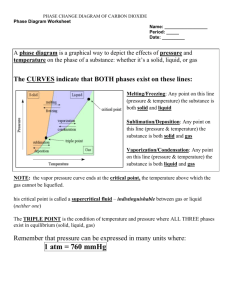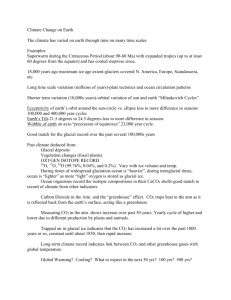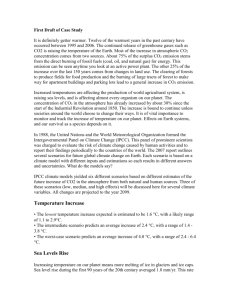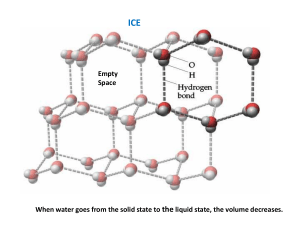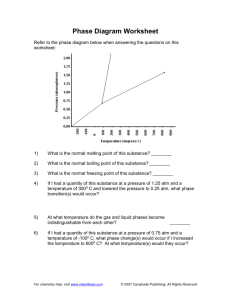Lab: Triple Point of Carbon Dioxide
advertisement
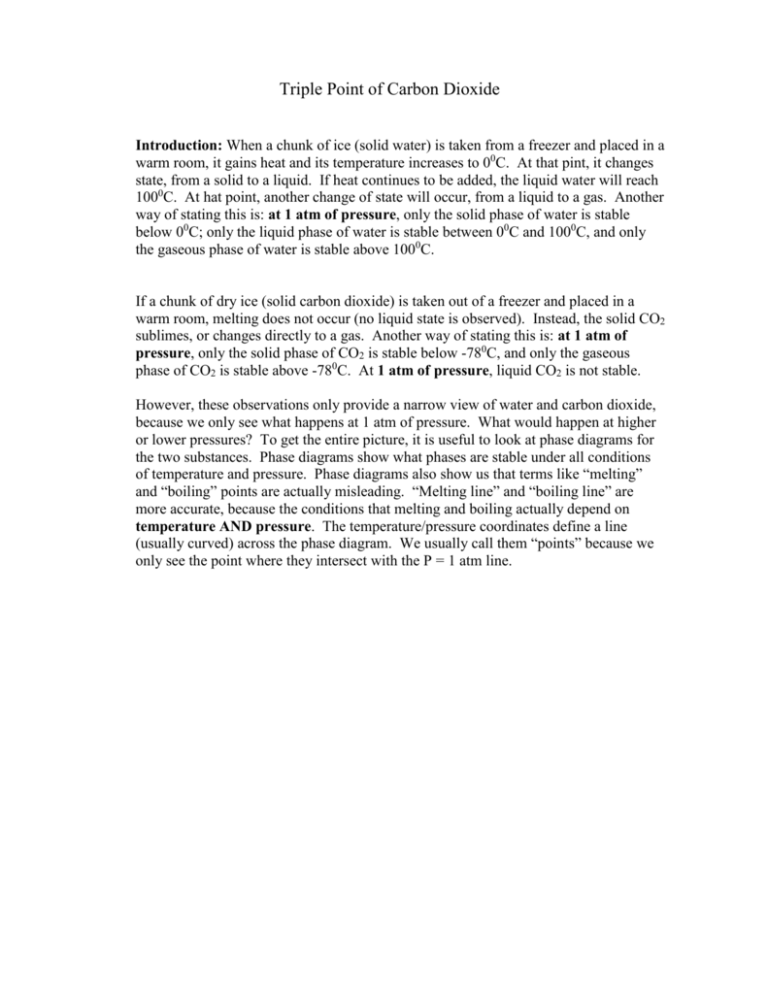
Triple Point of Carbon Dioxide Introduction: When a chunk of ice (solid water) is taken from a freezer and placed in a warm room, it gains heat and its temperature increases to 00C. At that pint, it changes state, from a solid to a liquid. If heat continues to be added, the liquid water will reach 1000C. At hat point, another change of state will occur, from a liquid to a gas. Another way of stating this is: at 1 atm of pressure, only the solid phase of water is stable below 00C; only the liquid phase of water is stable between 00C and 1000C, and only the gaseous phase of water is stable above 1000C. If a chunk of dry ice (solid carbon dioxide) is taken out of a freezer and placed in a warm room, melting does not occur (no liquid state is observed). Instead, the solid CO2 sublimes, or changes directly to a gas. Another way of stating this is: at 1 atm of pressure, only the solid phase of CO2 is stable below -780C, and only the gaseous phase of CO2 is stable above -780C. At 1 atm of pressure, liquid CO2 is not stable. However, these observations only provide a narrow view of water and carbon dioxide, because we only see what happens at 1 atm of pressure. What would happen at higher or lower pressures? To get the entire picture, it is useful to look at phase diagrams for the two substances. Phase diagrams show what phases are stable under all conditions of temperature and pressure. Phase diagrams also show us that terms like “melting” and “boiling” points are actually misleading. “Melting line” and “boiling line” are more accurate, because the conditions that melting and boiling actually depend on temperature AND pressure. The temperature/pressure coordinates define a line (usually curved) across the phase diagram. We usually call them “points” because we only see the point where they intersect with the P = 1 atm line. In this lab, you will have a chance to see something very few people ever see: liquid carbon dioxide. You will also witness a rather unusual phenomenon known as triple point. This is the point at which the solid, liquid and gas phase of a substance co-exist. For any given substance, there is only one triple point. For CO2, triple point occurs at -570Cand 5.2 atm (for water, it is 0.010C and 0.0030 atm!). Materials/Safety: Plastic cup, plastic pipette, dry ice, scissors, water, dry ice, goggles, apron, pliers, weigh boat Procedure: 1. Cut off the end of several pipettes (leave about 1 inch attached to the bulb). 2. Obtain a plastic cup and fill it with water (almost to the top). 3. Take a weigh boat to the supply counter and get dry ice from your instructor. You may need to crush the ice into a fine powder). 4. Scoop the dry ice into the empty pipette – fill it about half way. 5. Bend the end of the pipette over and clamp it shut with the pliers. Immediately submerge the pipette in the cup of water. Make sure no gas bubbles are escaping! 6. Observe the contents of the bulb from the side. You should see the solid dry ice, and gas subliming from the ice. As the gas pressure builds to 5.2 atm, you will see liquid CO2 begin to form. 7. Record observations in your Data section. Use pictures and words (paragraph) to describe what you saw. Data: Analysis: 1. What is sublimation? 2. Use 2 phase diagrams (label each completely!) and no fewer than 15 words to explain why some substances melt then boil, while other substances sublime. 3. What is misleading about the terms melting point and boiling point? 4. The following statements are not completely true. Change them to make them true. “Water always boils at 1000C.” “Liquid CO2 is not stable, so we never see it.” 5. Is it possible to have boiling ice water? Explain. Conclusion:

